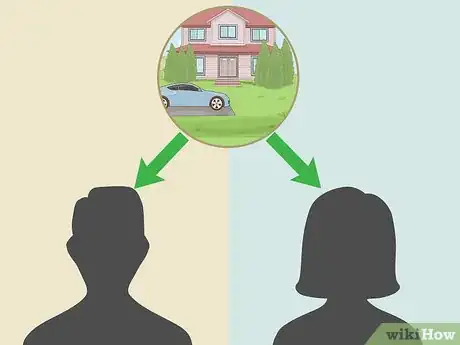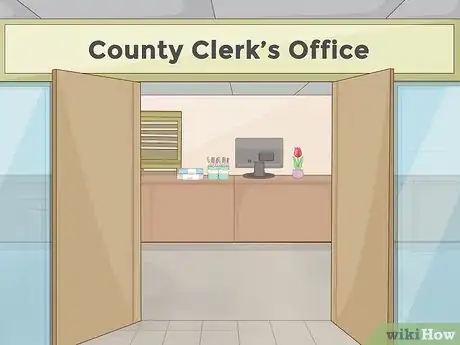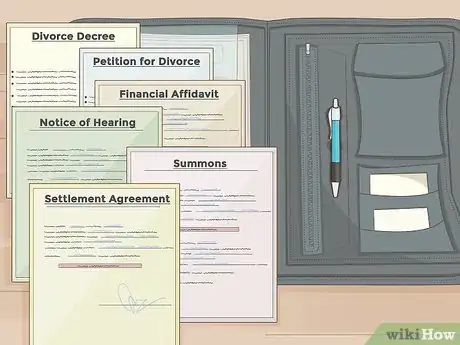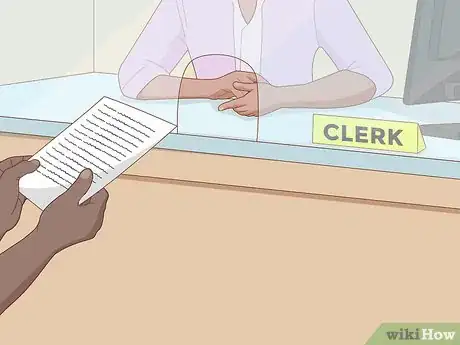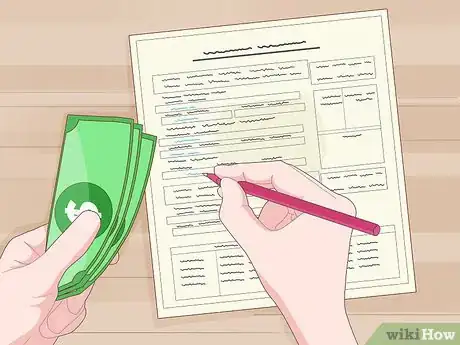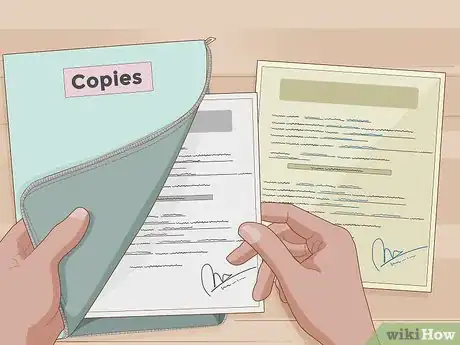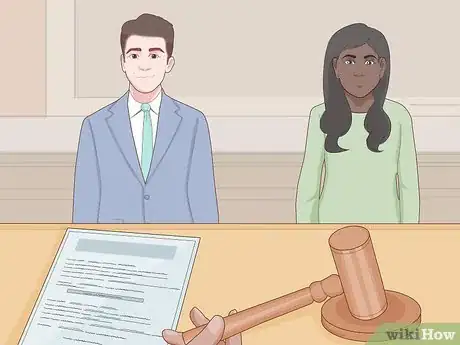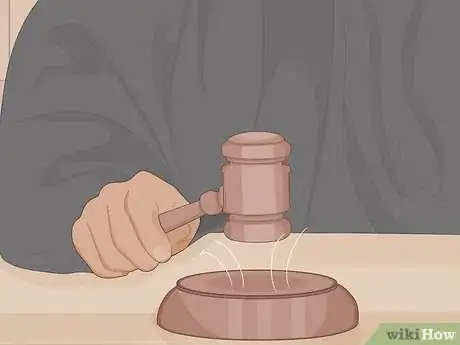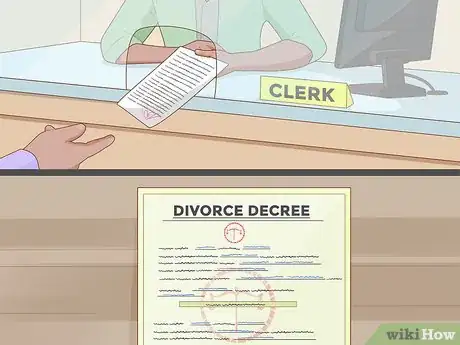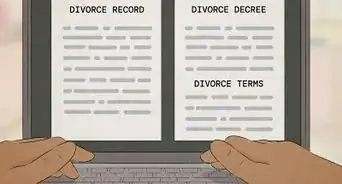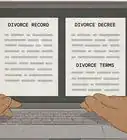This article was co-authored by Clinton M. Sandvick, JD, PhD. Clinton M. Sandvick worked as a civil litigator in California for over 7 years. He received his JD from the University of Wisconsin-Madison in 1998 and his PhD in American History from the University of Oregon in 2013.
There are 10 references cited in this article, which can be found at the bottom of the page.
wikiHow marks an article as reader-approved once it receives enough positive feedback. This article has 13 testimonials from our readers, earning it our reader-approved status.
This article has been viewed 891,949 times.
In some circumstances, you may be able to divorce your spouse without hiring and paying for an attorney. This process is commonly referred to as a pro se, or “on your own behalf”, divorce. It is simply a matter of completing the paperwork, filing it with the court, and attending a hearing, all of which you can do on your own. A "do-it-yourself" divorce is not always wise, but it may be an option if money for an attorney is a concern and your divorce isn't too complicated.
Steps
Deciding if You Should File for Divorce on Your Own
-
1Discuss divorce with your spouse, if possible. If you both agree on the conditions of your divorce, filing your own divorce papers may be an option. However, it is not always possible to discuss a divorce in a civil matter or reach an agreement on all issues, particularly if you have children together. If you cannot agree, you are likely to need the assistance of an attorney to protect your interests.[1]
-
2Decide if a pro se divorce is appropriate for your situation. While some situations are easily handled on a pro se basis, others are far too complex to be handled pro se. Generally, you are a good candidate for a pro se divorce if the following facts are true:[2]
- You have been married for a relatively short period of time.
- You have no children together, or you and your spouse agree on all matters relating to the child(ren), including custody, visitation, and child support.
- You and your spouse don't have a lot of money, marital property, or shared debt to divide.
- Neither of you own significant stocks, bonds, or other investments.
- You don't suspect your spouse is hiding any financial assets and you're not filing for bankruptcy.
- Neither of you is in the U.S. military.
- You are not the victim of spousal abuse.
- You are not requesting that your spouse pay you alimony or spousal support.
Advertisement -
3Determine if any major issues exist. When you talk with your spouse, discuss all issues related to the divorce in order to ensure that you both are in agreement on each issue. The issues that you should discuss, which may vary based on your situation, may include:[3]
- Division of assets, including any real estate, bank accounts, vehicles, and personal property
- Division of debts, such as mortgages, vehicle loans, student loans, and credit card debts
- How you will remove one spouse’s name from joint assets and debts, such as jointly held mortgages, deeds to property, vehicle loans, vehicle titles and registrations, bank accounts, and credit card accounts
- Custody, visitation, child support, and health insurance coverage for any children
- Alimony or spousal support to be paid from one spouse to the other following the divorce
- Restoration of the wife’s maiden name or previous married name
-
4Decide if you want or need help. While it is possible to file for divorce on your own, it is often useful to get some help during the process, even if you choose not to hire an attorney to represent you in the divorce. Here are some ways that you can ensure that you are completing the divorce process properly.[4]
- It is possible in some states to get a lawyer to look over your paperwork and give you a limited amount of advice at a much cheaper price. This is a good way to double-check your work and get any questions that you have answered.
- You and your spouse can meet with a mediator, or a neutral third party who is trained to resolve disputes, in order to ensure that you are in agreement on all issues regarding the divorce. Many states require this as part of their divorce proceedings.
- Some states have legal document preparers (LDPs), which are businesses that will submit completed legal documents for you. While they cannot give you legal advice, they can ensure that there aren't any problems with your paperwork. [5]
Filing the Appropriate Paperwork
-
1Visit the court clerk’s office in the county in which you live. The clerk’s office may be able to confirm that you have all of the right forms or documents and answer many questions that you may have about the process. However, the clerk’s office cannot give you legal information.[6]
-
2Obtain the forms necessary to file for divorce. Some states or counties have websites with links to the forms you need to file for divorce. Some clerk’s offices have forms that you can pick up in person, or that they will provide to you by mail. These form already have the legal language in place with spaces where you can fill in details for yourself and your spouse. Every state requires specific forms, and some states may require forms that other states do not. The most commonly required forms include:[7]
- Petition for Divorce – This document requests that the court grant you a divorce.
- Summons - This form directs a police officer or sheriff’s deputy to contact your spouse and let him or her know that you are filing for divorce and that he or she has the right to respond.[8]
- Financial Affidavit - You and your spouse are each required to fully disclose your respective financial situations on this form.
- Notice of Hearing - This form is filed to allow the court sets a date for your court hearing.
- Settlement Agreement – This form can be filed with the court if you and your spouse agree on all issues related to the divorce.
- Divorce Decree – This form is the document that the judge will sign to formally grant your divorce.
-
3File the necessary forms with the clerk’s office. This is the first step to formally placing your divorce petition on file with the court. The clerk’s office will require you to file a certain number of copies of the documents, along with the original documents. Check with your clerk’s office beforehand in order to determine how many copies are necessary.[9]
- Many states require that you be a resident of the state and/or county for a certain period of time before being eligible to file for divorce. Check with your clerk’s office about your state’s eligibility requirements, or look them up online.
-
4Pay the court’s filing fee. All courts charge a filing fee to file for divorce, which varies widely from one state and even from one court to the next. In most jurisdictions, the filing fee ranges from $100.00 to $300.00.
- If you cannot afford to pay the court’s filing fee, you may be able to ask the court to waive the normal filing fee. In many states, if you qualify for public assistance or your income is below the federal poverty guidelines, you can file in forma pauperis (IFP) or fee waiver request forms with the clerk’s office. These forms request the court to waive the normal filing fee. The court may or may not grant your request, depending on your local court practices and your individual circumstances.
-
5Always keep copies of all documents. Whenever you turn in a completed form, always keep a copy that has been file-stamped by the clerk’s office for your own records. That way you have proof that you submitted the document, and a back-up copy in case the original gets lost somehow.[10]
-
6Stay organized. In addition to keeping copies of everything, make sure you file and store your paperwork in a safe place. You'll want to include things like receipts for fees paid, all signed documents, and explanatory information given to you by the clerk’s office.[11]
Appearing in Court
-
1Receive your court date. You will be notified of the date and time of your court hearing by mail. Your case will be put on a docket for some time in the coming months. However, not all states require a hearing. To determine which states require a hearing, click here
- There are different types of court hearings that may be scheduled in your case, depending on your state’s laws and your local court’s practices. For instance, you may have a provisional or preliminary hearing, which deals with temporary orders, usually dealing with children and possession of the marital residence and vehicles, while your divorce is going on. You may also have a final divorce hearing, at which the court is likely to grant your divorce. Other states and courts may require additional hearings as needed.
-
2Be prepared. If you must attend a court hearing, bring all of the necessary materials with you to your court date. This includes required signed paperwork and any other required documents. Even uncontested divorces can take months, so you don't want to slow down the process even more by having to reschedule your court date because you don't have all of the right information.
-
3Dress appropriately. Remember that the courtroom is a professional place and the decision of the judge will be final. Therefore, you'll want to dress in a respectable fashion since you are representing yourself.
-
4Know what to expect. If you and your spouse have amicably settled your divorce and you appear in court, it is likely that the judge will simply give you what you have asked for, especially if there are no children involved. If, however, there seems to be disagreement or hostility between you and your spouse, the judge may order that you attend mediation before ruling on your case.[12]
-
5Attend the court hearing. Remember that whatever is decided in the hearing is final. You will not be able to go back later and change the settlement agreement.
Finalizing the Divorce
-
1Comply with all divorce and court requirements to get divorced. The whole process can take months until the divorce is finalized. It is important that you always know where your case stands and what you need to be doing to help the process along. It is possible that the court might be waiting on you to act, so you need to know what's happening so you can finalize the divorce in a reasonable amount of time.[13]
- Many states have waiting periods before your divorce can be granted. This waiting period may be as little as 60 days or as long as six months.
- If you and your spouse have minor children together, your state laws or local court rules may require you both to attend a parenting class for divorced or separated parents. Taking the class may involve the payment of a small fee, usually ranging from $20.00 to $30.00. Some courts will not allow you to get divorced if you have not attended the class as ordered.
- Some courts will not allow you to get divorced if the wife is currently pregnant. Depending on your state’s laws, the wife may have to first give birth and prove that the child does not belong to the husband before the divorce will be granted.
-
2Obtain a copy of the divorce decree. Get a certified copy of your divorce decree from the clerk’s office or the court administrator’s office. You'll need a copy of your divorce decree for many things in the future, such as buying a house or getting remarried, so make sure you get a certified copy and put it in a safe place. You also will need it in order to officially change your name if your divorce granted you the right to return to your maiden name or a previous married name.
-
3Follow all guidelines set up by the court. Whatever the judge decides, you have to follow. Make sure you abide by the judge's ruling to avoid possible financial or legal consequences.
Warnings
- All states have different requirements for divorce proceedings, so it is important that you find out what your state specifically requires before you proceed.⧼thumbs_response⧽
- Hiring an attorney is a must if your spouse hires one.⧼thumbs_response⧽
- You may want to hire an attorney if you feel the court is hostile to pro se divorces or is treating you unfairly.⧼thumbs_response⧽
References
- ↑ http://family.findlaw.com/divorce/uncontested-divorce.html
- ↑ http://family.findlaw.com/divorce/divorce-information-by-state.html
- ↑ http://family.findlaw.com/divorce/checklist-documents-to-show-your-divorce-attorney.html
- ↑ http://family.findlaw.com/divorce/do-you-need-a-divorce-lawyer.html
- ↑ http://www.divorcenet.com/states/nationwide/dnetart-01.html
- ↑ http://family.findlaw.com/divorce/where-to-file-for-divorce.html
- ↑ http://family.findlaw.com/divorce/divorce-forms-by-state.html
- ↑ http://www.jud.ct.gov/publications/fm179.pdf
- ↑ http://family.findlaw.com/divorce/where-to-file-for-divorce.html
About This Article
To file for divorce without an attorney, talk it through with your spouse beforehand, if you can, to divide up assets and debts and discuss custody of children, if you have any. Go online or visit your county clerk's office to get the forms you'll need, like the petition for divorce and summons. File them with the clerk and pay the filing fee. If you're appearing in court, behave professionally to show the judge that they can settle the divorce easily. For more tips on filling out documents and finalizing your divorce, read on!


